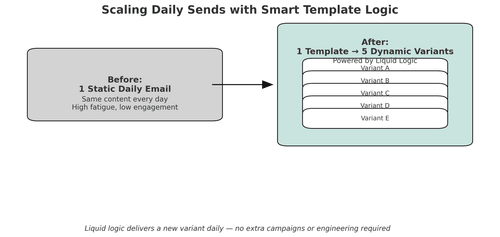
Scaling Up Templates Without AI
Tools: HTML, Braze, Liquid Logic, Figma
Problem:
Our most popular email template was sending out with the same content to users every single day. This ran the risk of creating user fatigue, and causing these messages to go directly into the trash. How can we scale up our program effectively without the help of engineering or expensive AI?
Strategy:
Through the use of a templating logic, I would combine several templates under the same step. This allowed us to avoid excessively complex campaign flows, but inserts more creative into our lifecycle programs.
Results:
The scaled up template held 5 variants of the code in one step and significantly outperformed the original.
My Story:
When I started in my position, I couldn't help but start on a campaign audit. The team's ESP had been live for over 5 years, and the lifecycle programs were sprawling. The one thing I noticed? Our biggest sends were delivering repeat content, growing stale after years of use.
The solution wasn't as simple as just creating additional campaigns in the existing flow - these were the type of campaigns that needed to trigger every day with updated user information. It wouldn't be as simple as splitting the audience based on traditional user information. We needed to scale smartly.
My process was:
1. Create the copy and content for 5 email sends. This was variations in the Figma design, and different eye catching copy.
2. Compile the content into their own arrays, hosting all the of the content.
3. Create some liquid logic to deliver one of the 5 variants based on time of send (this was split by 1: second of send or 2: day of week).
4. Insert the logic throughout the template and manually QA all 5 versions of content.
5. Test, monitor, and adjust.
Outcomes:
There was an almost immediate increase in performance with these campaigns. Templates that were recognized now saw variety. Users responded well to a change in business as usual.
When you're dealing with the budget of an enterprise company, you have the ability to scale with AI in ways that create unique user experiences. How do the smaller teams compete?
Be clever with the basics, and think outside of the box.
